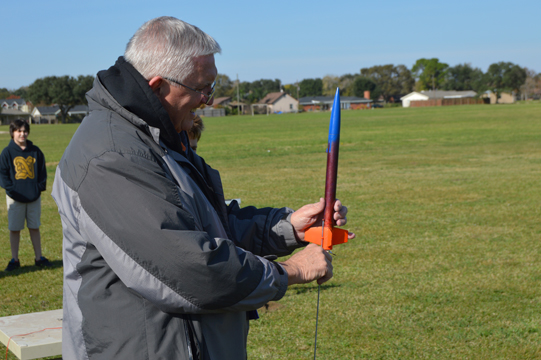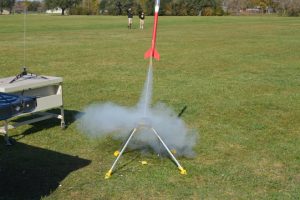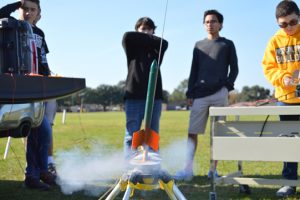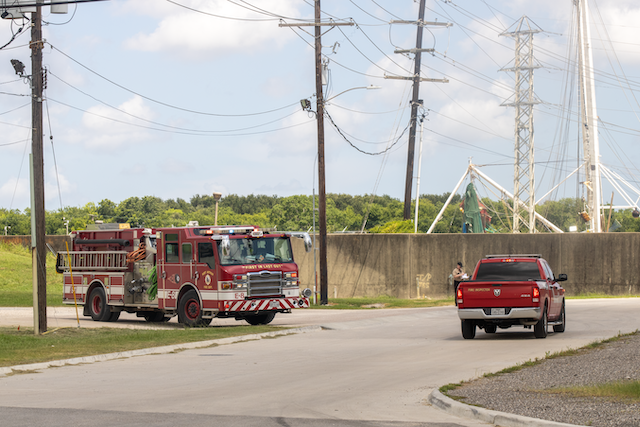Science raises excitement, understanding with rockets
Published 10:28 am Friday, December 16, 2016

- Math teacher Bill Decker sets up one of the rockets for launch behind CO Wilson Middle School in Nederland. (Lorenzo Salinas/The News)
Theory becomes tangible when there’s ignited gunpowder packed with it.
Bill Decker, math teacher at C.O. Wilson Middle School, launched student-made rockets Thursday with students from Wilson’s aerospace class. A sizeable crowd of fellow students and younger classmen were also present for the multi-period demonstration.
“We’re studying aerodynamics,” Decker said. “We first started with paper planes, then we moved on to building solid fuel rockets.”
Trending
Decker explained that when the gunpowder in the rocket is ignited, it emits an exhaust gas that pushes the rocket upwards to 1,200 feet in the air.
“The charge at the nose cone (then) releases and a parachute pops out and carries it down to the ground,” Decker said.
There was apparently more to the launching than just watching homemade rockets take off, however.

Students’ homemade rockets launch behind CO Wilson Middle School as part of their aerospace class. (Lorenzo Salinas/The News)
“I taught them some trigonometry so they can measure how high the rocket goes,” Decker said of his math students.
And it would certainly not be the first time Decker has worked with aerospace engineering before.
“I have worked with education initiatives like High School Aerospace Scholars (HAS) at NASA,” Decker said.
Trending
“It’s hosted 40 high school seniors each week, where they plan a mission to Mars and present their findings to NASA scientists and researchers.
“They get to meet engineers who research and design. They even meet astronauts.”
Decker’s work with NASA has included various education-themed programs since 2002.
“I started, off and on, in 2002 …” Decker said. “In ’07 I went into the Space Academy for Teachers. In ’09 I went into the advanced academy. In 2011 I selected a team for NASA’s ‘Vomit Comet.’”

Math teacher Bill Decker sets up one of the rockets for launch behind CO Wilson Middle School in Nederland. (Lorenzo Salinas/The News)
When asked about the value of such projects as the rockets, Decker responded,
“It opens minds. Kids are used to video games, but this is hands-on — it’s hands-on construction and hands-on science.”
Decker elaborated on the importance of practical experiments and raising students’ interests in the sciences.
“Most of them have never done this before. They’re not sure what will happen,” Decker said.
“So, when they see the rocket launch and fly, they become excited and that starts their curiosity and problem-solving.”
Decker said the students become very wrapped up in the engineering and science process.
“I think when the seventh- and eighth-graders see it and get excited, their enthusiasm spreads to the others,” Decker said. “Now the fifth-graders are looking forward to it.”
Decker said he hopes that his math and aerospace work with the school would be the proverbial match fire that would spark interest in students about math and the sciences.
“I hope they’ll apply it in the future — in high school, in their (future) jobs — in engineering and technology,” Decker said.
Decker said sparking curiosity is very important.
“Sometimes they’ll ask me a question and I’ll say ‘Go look it up.’ I know the answer, but I want them to find it out on their own.”
Decker said he checks their findings to ensure they have the correct information.

Students watch as one of their homemade rockets launches behind CO Wilson Middle School as part of their aerospace class. (Lorenzo Salinas/The News)
Among his students present at the rocket launch, eighth-grader Amber Borel had built one of the rockets being launched into the air for her engineering graphics and aerospace class.
“I really like building stuff,” Borel said. “It’s awesome.”
Borel expressed interest in either becoming an engineer or a marine biologist in the future.
When asked her favorite part of Decker’s class, Borel said it was mathematics.
“I like the formula for how high the rockets can go,” she said.





